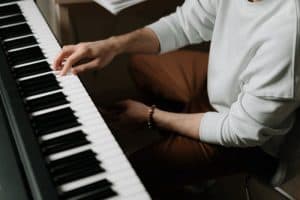If you are just starting out on the piano, mastering scales and arpeggios will make learning a song far easier. Rather than seeing each dot as a lone note, you’ll be able to spot a pattern of notes and know very quickly what it is and how to play it.
You’ll find these patterns come up over and over in many songs, so being able to recognize them – and play them using the best fingering – during your daily practicing, will really help you get ahead with your piano skills!
- Fall in love with the music - Learn your favorite songs, at a level suitable for you.
- Enjoy interactive piano lessons - Explore courses covering music theory, technique chords & more.
- Get real-time feedback - Skoove's feedback tells you what went well and what needs practice.

Learn to recognize the patterns
Take a look at the two snippets of music above. The first one – a scale – runs step-by-step up each note on the piano. The second one – an arpeggio – jumps over the 2nd, 4th, 6th and 7th notes. By learning to visually recognize these patterns (or small portions of them), you can learn songs much faster.
A lot of music uses two different patterns of notes:
Type one is a “scale” which moves from one note to the next either up or down without missing out any notes: Type two is an “arpeggio”. They skip every other note twice and then skip two notes. They are basically broken up chords:
Type two is an “arpeggio”. They skip every other note twice and then skip two notes. They are basically broken up chords:
How piano scales work
First we’ll take a look at how to play the C major scale. We’ll start with the key of C because it has no black notes and is therefore the easiest to understand.

All major scales are built with the same distance between each note. It’s best to understand intervals of a whole tone and a halftone first, then you can quickly work out a scale in any key.
Take this Skoove lesson to understand whole tones and halftones. Learn to play the C major scale step by step with Skoove’s lesson and learn to play the song “Piano Man”.
To play an 8-note (or “one octave”) scale, you’re going to run up the ladder using finger numbers 1, 2, 3 – 1, 2, 3, 4, 5. To get from finger 3 on E to finger 1 (thumb) on F, you need to pass your thumb underneath your 3rd finger. Try not to twist your wrist too much as you move your thumb under. Keep your hand relaxed and slightly lifted all the time.
Now walk back down the notes starting with finger 5 on the high C. When you reach your thumb, swing finger 3 over your thumb and place it on E, then use fingers 2 and 1 to finish the final two notes – D and C. When you get to the highest note, just play it once, then run down the scale again, like this: 
What you’ve just learned to play is a “1 octave scale of C major”. Play it several times, aiming for a smooth and even flow of notes.
Next, learn to play the C scale in the left hand. The left hand is a mirror image of the right, so when you climb up the notes, you will swing the 3rd finger over and when you go back down you’ll pass your thumb under the third finger, like this: 
Scales begin on the note name of the scale. So a “C scale” begins on a “C” and an “A scale” begins on an “A”, etc.
You can develop your scale practice to cover two octaves, then three, then four. There are two main types of minor scale – harmonic and melodic. We are just going to talk about the harmonic as that is the most commonly used and the best one to start with.
The harmonic minor scale differs from the major scale by having flattened 3rd and 6th notes. Use the same fingers you used to play the major scale. Here is C minor: 
Once you’ve got it flowing in the right hand, learn it in the left hand.
Another type of scale worth learning and practicing is the chromatic scale.
How arpeggios work
Like scales, they also can be either major or minor. In the case of the latter, the only difference between them being major or minor is that the second note of the arpeggio is flattened. They bring texture to music and are often used in the left hand accompaniment.
They can be thought of as broken piano chords. Think of the scale you just learned with its 8 notes but skip the notes 2, 4, 6 and 7, and you have an arpeggio! In other words, you play notes 1, 3, 5 and 8 (8 is the same note as 1 but an octave higher). Without the top note, it’s a broken chord. Here is the C major arpeggio: The fingering is different from the previous. Place your right hand thumb on note C, place finger 2 on the note E, finger 3 on the note G, then play the high C with finger 5. Play through the notes, releasing each note as you play the next one, and move your hand up to play 5 on the high C. You should keep your hand very relaxed and not over-stretch. Again, the left hand is a mirror image. The fingering is 5, 3, 2, 1.
The fingering is different from the previous. Place your right hand thumb on note C, place finger 2 on the note E, finger 3 on the note G, then play the high C with finger 5. Play through the notes, releasing each note as you play the next one, and move your hand up to play 5 on the high C. You should keep your hand very relaxed and not over-stretch. Again, the left hand is a mirror image. The fingering is 5, 3, 2, 1.
Minor arpeggios
Now let’s take a look at the C minor arpeggio. Notice that the sound takes on a “sad” or melancholy sound compared to the major. Although the only difference between the major and minor patterns is that the second note is flattened by one semitone. Other than that, they are the same and match the chord. Here is the C minor arpeggio played by the right hand: 
Why should you learn and practice scales and arpeggios?
As Disney’s cartoon Aristocats knew, to be a “truly cultured music student”, scales as well as arpeggios need practicing! There are two really good reasons to learn them.
- Develop strong fingers and controlled, steady notes. This evolves over time to controlled, even playing of songs, even at high speeds.
- Learn and understand different key signatures, giving you the basic understanding of music theory.
Once you’ve learned the G major scale, you’ll know that G major has an F# in it. When you next see a piece of music with a key signature of one sharp (F#) you’ll know that song uses the G major scale.
How are scales and arpeggios used within music?
Both Classical and pop songs use these notes that are like broken piano chords. Sometimes it’s more obvious in one song than another. Here are some famous piano songs that clearly use these notes:
Mozart Sonata in C major begins with broken C major chords in the left hand and moves on to some fast patterns in the right hand. It goes on to have many arpeggios in each hand.
Begin learning a song that has arpeggios!
Leonard Cohen’s “Hallelujah” uses them in the left hand, moving between several keys throughout the song. Learn to play “Hallelujah” with Skoove right now.
Beethoven’s Moonlight Sonata 3rd Movement is another great example of building a piece of music using these note patterns. In the opening the right hand is nothing but arpeggios, although they are not climbing straight up but falling back one note after every three notes up.
Try the first part of Beethoven’s Moonlight Sonata with this Skoove lesson. This uses broken chords in the right hand, the first step to playing full arpeggios.
Try this lesson, “Canon in D” which explains more about how to play them.
How fast should you play your piano scales and arpeggios?
By practicing these notes piano students gain a lot of technique. Start with slow, steady practice using a metronome, not only when you’re starting out but even when you get more advanced. Slow practice builds relaxation into your hands which is vital to achieve playing at high speed.
Practice using a metronome
It’s a good idea to gradually increase your speed over time. Use a metronome and up the speed by 10 bpm each week. This is a good plan for most people. Eventually, you want to be able to play them very fast and fluently going from key to key.
Ready to get playing?
Learning piano scales and arpeggios bring improved piano or keyboard skills very quickly. Learn to recognize the patterns in the sheet music and you’ll be able to find the notes and learn a new song much faster and have that music ringing out! Be a “truly cultured music student” and you’ll soon be glad you put in the time to practice them! Start your piano journey with Skoove right now!
Author of this blog post:

Georgina St George has been playing piano most of her life. She has a thriving piano school on the south coast of England. She loves to infuse her students with her passion for music, composing and performing. Her music has been featured on over 100 TV shows and her musicals have been performed in New York and London’s West End.














